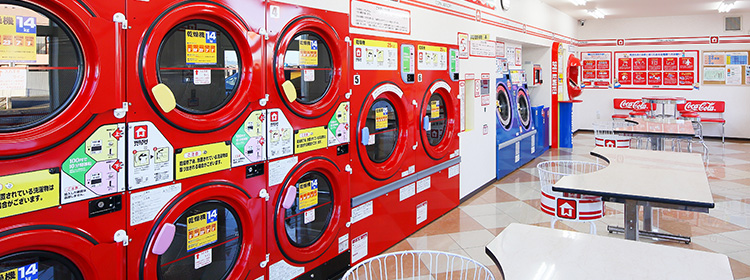
Coin-operated Laundry Business Model
WASHHOUSE did not originate as a coin-operated laundry business.
Above all, we were founded as "a provider of services using a system."
WASHHOUSE is rooted in a pioneering approach to designing and constructing
a new business mechanism that can bring in continuous profit.
We chose the coin-operated laundry business as a "target" for applying the new mechanism.

POINT 1Characteristics of the coin-operated laundry business
Coin-operated laundry is a truly unique business. The machines operate and use detergents and gas only after coins are fed in. Inventories and losses are thus avoided.
For that reason, the business can be managed and sustained even with a small number of users.
Coin-operated laundry stores are also unattended. Labor costs can be kept to a minimum and the abilities of individuals have no affect on the business. As of today, the industry is dominated by private firms that tend to be old-fashioned, lack a sophisticated management awareness, and respond slowly to laws and regulations.

POINT 2Social background: Why society needs coin-operated laundry
The number of patients seeking medical attention for allergies such as atopic dermatitis has been increasing in recent years. The allergies are often triggered by dead mites and their droppings.Hay fever and health damage from PM2.5 are also pressing problems.
We live in an age where two out of three newborns have some sort of allergy.
Within the highly sealed structures of modern-day houses, mites can reproduce at alarming rates. Just one mite can produce 300,000 progenies in a single month, even in a new futon.
Many families also face laundry-related challenges at home. Some cannot set up washers and dryers in their apartments. Others have machines too small to accommodate large articles like futons or cannot hang their laundry out on balconies. Two-income families may lack the time to manage laundry at home. Families with children tend to generate too much laundry to handle. Coin-operated laundry is playing a more important part in our lives for these reasons.

POINT 3Hopes for the future of coin-operated laundry
According to a "Survey on coin-operated laundry business facilities" conducted by the Ministry of Health, Labour and Welfare, the number of coin-operated laundry facilities in all of Japan in fiscal 2013 was 16,693. Coin-operated laundry had grown at a CAGR (compound annual growth rate) of 2.9% since 1996, when there were 10,228 facilities.
The growth of coin-operated laundries has been driven partly by the needs of working women in two-income families. These women and their families wish to "reduce time spent on laundry," take steps to prevent allergies like hay fever, and rely less on dry cleaning now that high-quality clothing is available at lower prices. Another factor behind the growth of coin-operated laundries is an increased awareness of cleanliness.
The "utilization rate" represents the proportion of households located within a 2 km radius of our stores who use coin-operated laundries. The utilization rate has more than doubled in the past 10 years and is expected to rise further (according to our research).
